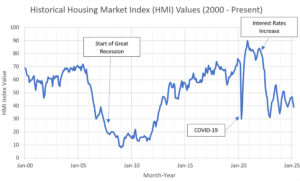
Housing Market Index (HMI) Survey, March 2025. Source: NAHB/Wells Fargo. / Graphic Credit: Brian Zweifel, Wisconsin DNR
By Brian Zweifel, DNR Forest Products Specialist, Dodgeville
Brian.Zweifel@wisconsin.gov
Variability and uncertainty seem like key words to describe many things right now, but the words apply especially to current housing markets.
The home construction and remodeling industry is a key driver of forest products markets and can be an important indicator of future demand. Softwood lumber and engineered wood products such as oriented strand board, plywood and laminated beams and joists are used in home construction. Hardwood lumber, however, is used to manufacture flooring, cabinets and other millwork items for interior applications.
One way to visualize the health of the U.S. residential construction industry is to look at Housing Market Index (HMI) values (Figure 1). The index measures the sentiments of home builders throughout the United States through surveys. A more complete explanation of HMI can be found in this brief video, but an easy way to understand the HMI value is that if half of the builders’ responses come back with “good” forecasts and half predict “poor” market conditions, then this index will give a value of 50.
Wisconsin has seen a lot of changes in housing trends over the last few decades, but none were greater than the housing market collapse of 2007. The residential construction industry scaled back its output significantly for several years, contributing to affordability issues in a market that already had a low supply of homes. Of special note, HMI values started plummeting well before the onset of the Great Recession that officially began in December 2007, offering an early warning to the dramatic downturn.
Although short-lived, a very significant drop in the HMI came at the onset of the COVID-19 pandemic. While mortgage rates were low and the lockdown kept cash in people’s pockets, a bonanza of new construction and remodeling took off as people had more available time and money to improve their existing homes or build new. As a result, HMI values rebounded and soared to all-time highs. During this time, we saw a major increase in prices for both hardwood and softwood lumber, although a portion of the increase was also due to supply-chain disruptions. When mortgage rates increased in 2022, there was a steep drop in builder sentiment and the HMI dropped to levels nearly as low as the COVID-19 shock. Prior to 2020, the HMI hadn’t been that low since 2012, as the index was sluggishly improving from the historic lows of the Great Recession.
When the economic shocks of the 2020 COVID-19 pandemic, subsequent supply chain disruptions and interest rate hikes for borrowers took effect, affordability became an even larger obstacle for many, especially first-time buyers. New challenges now appear to be impacting affordability, even as prices for forest products used to build homes have moved lower. In a March 2025 news release, the National Association of Home Builders (NAHB) Chief Economist Robert Dietz said, “Construction firms are facing added cost pressures from tariffs. Data from the HMI March survey reveals that builders estimate a typical cost effect from recent tariff actions at $9,200 per home. Uncertainty on policy is also having a negative impact on home buyers and development decisions.” Like the nation’s home builders, Wisconsin’s forest products industry will have to wait and see what happens with these trade policies.
Over the past 25 years there have been some significant ups and downs in the index, but the past 5 years have shown increased volatility in perceptions. While we still have some way to go before HMI levels drop to the record lows of 2007-2012, the sentiments expressed by the nation’s homebuilders should be treated as a possible “canary in the coal mine,” alerting us to the possibility of trouble ahead in residential construction and the forest products marketplace.
In a future article, we will look at another trend that has impacted Wisconsin’s forest products sector since the economic downturn nearly two decades ago, substitution of high-quality hardwood products with lower-grade painted products, engineered wood products, wood-look-a-likes and wood-alternative products like vinyl plank flooring.
